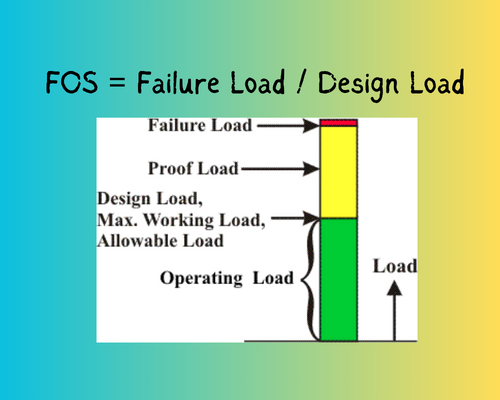Search This Blog
Most Popular
Sieve Analysis of Aggregates - ASTM Standard
August 11, 2021
Categories
- Building Construction (82)
- Building Materials (82)
- Columns (2)
- Concrete Beam (3)
- Concrete Construction Techniques (4)
- Concrete Mix Design (10)
- Concrete Repair (14)
- Concrete Slab (10)
- Construction Equipment (16)
- Construction News (7)
- Design of Structures (15)
- Engineering Drawing (1)
- Estimation (3)
- Geotechnical engineering (26)
- Highway Engineering (11)
- Innovations (30)
- Material Testing (9)
- Matrix Analysis of Structures (2)
- Mechanical Engineering (3)
- Strength of Materials (2)
- Structural Analysis (17)
- Structural Design (21)
- Structures (17)
- Transportation Engineering (9)
What is Factor of Safety (FOS) in Civil Engineering Design?
Neenu
October 26, 2023
The factor of safety (FOS) measures how much times greater the load-carrying capacity of a structural component is, than what is required. It is defined as the ratio of the capacity of the material to the demand for the material.
 |
Every structure and safety equipment in the construction and infrastructure industry is designed by considering the factor of safety. We determine the required overload expected for each unit to remain safe during an emergency. Hence, for more reliability, structures are built stronger than necessary. This way engineers can ensure that the structures are capable of withstanding greater loads than what they are expected to experience during their service life.
A structural component for example a beam needs to be designed to take up a maximum expected load of 100 tonnes. But we designed the beam for taking up to 250 tonnes. This extra increase of design load by 2.5 is to consider the risk of failure of the structure and overall safety. If we design the beam only for 100 tonnes, any unexpected increase in load would result in the collapse of the structure.
In general, the factor of safety (FOS) can be expressed as:
Factor of Safety (FOS) = Allowable Stress or Ultimate Load Capacity / Actual Stress/Expected LoadorFactor of Safety (FOS) = Actual Capacity/Demand Capacity
It must be noted that F.O.S. will always be greater than 1. This means the capacity of a material must always be greater than the demand on that material, in other words, the strength of a given material must be greater than the stress expected on the material.
Based on the above example:
Based on the above example:
Then, F.O.S can be calculated as:
F.O.S = strength of the beam/stress on the beam = 250/100 = 2.5.
Factor of Safety for Ductile and Brittle Materials
FOS value is used in the design of different structural members based on their behavior during their failure. In general,FOS of any material = Maximum Stress / Design Stress
Brittle Materials
In the case of brittle materials, the failure would be sudden during unexpected loads. Here we use the ultimate strength as maximum stress to calculate the safety factor of brittle materials.
FOS for Brittle Material = Ultimate Stress/ Design Stress = σut / σ design
Brittle failure occurs immediately after the elastic limit with small deformation. Hence, fracture and ultimate stress are the same in brittle materials, while calculating FOS.
Brittle materials have a non-homogeneous structure with residual stresses in the component. So for safety, a large factor of safety is used. Providing a higher value of F.O.S. during the design to provide enough room for evaluation or evacuation. The ultimate strength determines the safety factor until the failure.
 |
| Stress Strain Curve for Brittle and Ductile Materials |
Ductile Materials
For ductile material, the maximum stress used is yield strength to determine the safety factor.
FOS for Ductile Material = Yield Stress/ Design Stress = σyt / σ design
Beyond the yield strength of the material, the material is subjected to plastic deformation. Yield strength determines the factor of safety until the start of the deformation. But this state does not put the component to failure.
Hence, we provide a low value of F.O.S to the design of these structural members. For instance, structures like slabs and beams have ductile failure. They reveal their path to failure through hairline cracks before sudden collapse, leaving time for evaluation or evacuation.
If the structure is more Ductile, Low F.O.S and if more Brittle, High F.O.S.
Factor of Safety in WSM and LSM Design Method
In the Working Stress Method (WSM), the safety margin (FOS) is usually set higher because it assumes worst-case scenarios for loads and materials, aiming for a very safe design.
On the other hand, the Limit State Method (LSM) uses a more modern approach that considers uncertainties more precisely. It uses different safety factors for different situations, allowing for a safer yet more efficient design with lower safety margins.
This shift to LSM is based on advanced engineering practices and a better understanding of materials, making it possible to create safe structures with lower safety margins, which can be more cost-effective.
Most Visited
Sieve Analysis of Aggregates - ASTM Standard
August 11, 2021
How to Calculate Cement Required for Floor Tiling?
July 02, 2020
What are Infiltration Wells?
April 15, 2024
Cross-Section of a Road – Geometric Design of Highways
February 26, 2021
How to Choose Good Quality Aggregates for Construction?
August 10, 2021
Traverse Surveying - Objective, Method and Procedure
January 19, 2022
Construction ERP System – A Comprehensive Guide
December 12, 2024
Top 7 Waterproofing Materials for Concrete Roofs
December 13, 2024
Search This Blog
MUST READ
What is PERT? Objectives, Pros & Cons
September 10, 2017
Terzaghi's Equation: Soil Bearing Capacity for Foundations
March 02, 2022
Contact Form
Footer Menu Widget
Created By SoraTemplates | Distributed By Gooyaabi Templates


0 Comments
Commenting Spam Links Are Against Policies